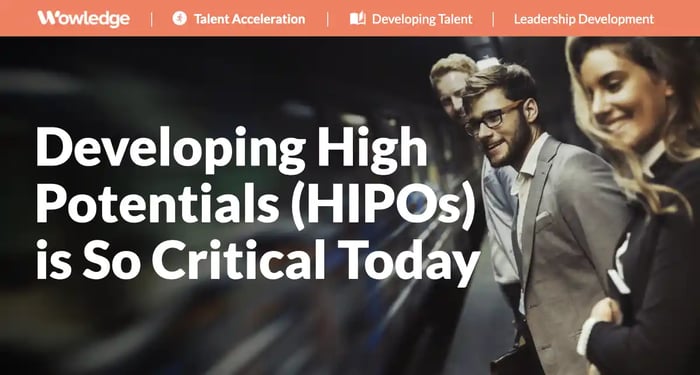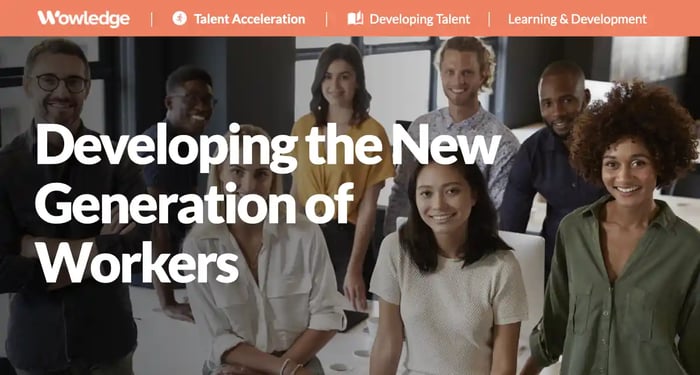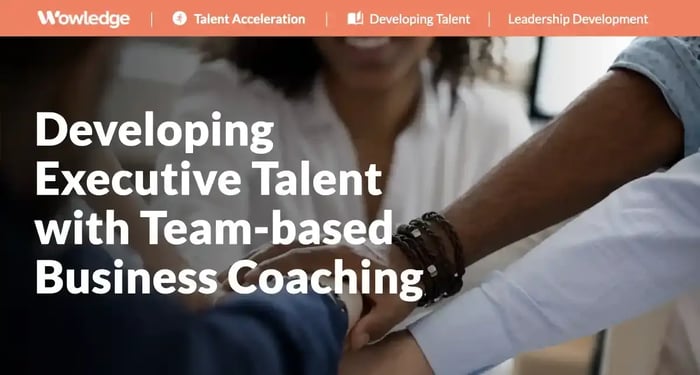With global labor markets making life difficult for hiring managers, recruiters, and talent planners, developing strategies to win the employment game is harder than ever. While most companies can maintain adequate staffing, the most challenging issue involves having the right pool of future leaders to guide the business. Without capable managers and leaders prepared to take over for the rapidly retiring Baby Boomer and Gen X leaders, there will be insufficient and ill-prepared resources capable of envisioning the future, strategizing, executing, planning, managing, and monitoring performance. Thus, there is an urgent need to focus on developing "high-potential" (HiPo) employees.
A disruptive trend has emerged involving a tendency of the next-gen workers and leaders to seek out career opportunities and options that are much more specific to their preferences – for example, greater meaning and social impact of their work, more development and coaching, and a greater “say” or influence in their goals and work methods. This trend has led to an increased (and faster or earlier) willingness to look for new jobs at organizations that can better meet their expectations and needs. In other words, increased turnover. The drive for developing HiPos to fill those roles in the future has never been more pronounced.
Millennials and Gen Z as “Job Hoppers”
The U.S. labor market continues to experience relatively high monthly turnover rates. With a monthly voluntary termination rate for non-farm workers hovering at or above 2% (January 2024), roughly 3.4 million people leave jobs across industry and government sectors. Adding in smaller amounts for layoffs and involuntary discharges at 2.1%, we see about 5.3 million people leaving their jobs every month, according to the Bureau of Labor Statistics’ (BLS) JOLTS report.
Hone in on the now-dominant generational groups in the labor force – the Millennials (currently aged 28-43) and Gen Z (16-27 years old), who comprise approximately 60% of the U.S. workforce. While long-term trend data suggests that young people across generations have always left jobs more quickly than their peers, the current trends appear to be worsening. Using data from the BLS, Recruiting.com reports that from 1983 to 2016, U.S. workers from ages 25 to 34 consistently had the shortest tenure across age groups, with a high of 3.2 years in 2012 and a low of 2.6 in 2000. In fact, of all age groups, the workforce's youngest generation has maintained the most consistent median tenure, hovering around a median of three years.
However, research by Gallup tells us that 21% of millennials have changed jobs over the past year, and another 50% say they will not be working at their current company in the coming year. Similarly, a millennial will stay at their job on average for only 2.75 years, with over 90% of Millennials reporting that they expect to change jobs every three (3) years. That is compared to the 9.9-year tenure average of workers aged 55-64. Equally concerning is the finding that 65% of Gen Z workers voluntarily resign in the first 12 months of employment and expect to change jobs ten times (10) or more between the ages of 18 and 34.
Given this challenging trend towards shorter tenures, the priority is heightened to maintain and develop a solid pool of future leaders who are fully ingrained in the company culture, understand ways of doing business and getting things done, and have networks of peers and advisors whom they can leverage and rely upon for support and collaboration. Again, we can see that developing HiPos is a priority for organizations across industries.
Why retaining these employees is so critical
Given that more experience is required to grow into leadership roles, the short tenures of this generation of workers have become a great concern. Longer-tenured employees tend to provide greater consistency of work outputs due to their passing through the learning and adaptation phase of new employment. With acclimation to a new organization, its culture, standards, and work methods comes an understanding of how to best accomplish tasks, workflows, and functional/departmental coordination requirements. With longer tenure, employees develop a more nuanced understanding of the organization's history, including past challenges and successes, allowing them to provide valuable insights into corporate strategic decision-making and problem-solving strategies. Knowledge and expertise in the organization’s operations create a cadre of more seasoned colleagues who can guide and mentor their junior counterparts who pass along the unwritten rules and guardrails that enable more efficient and effective task completion. Developing HiPos can offer higher retention and longer tenures by the special attention they receive on the career development front alone.
Furthermore, more experienced employees can leverage knowledge and relationships with peers and managers in other parts of the organization, enabling better coordination and collaboration for best practice sharing, innovation, and solution development. With specialized knowledge of customer preferences and methods to meet their evolving needs and preferences, invaluable insights can be generated that lead to increased sales, profitability, and retention.
Keeping a solid base of experienced leaders is even more of an issue when considering the relatively short tenures we tend to see with leaders. According to a 2020 Report by Korn Ferry, the average tenure of an executive is only 4.9 years, which has dropped significantly over recent years. The study found that the problem is even more pronounced among younger executives, making the prospects for having ready replacements even more dire.
The facts that support the power of various development methods to increase retention and engagement are well-established, led by talent development and mobility, with tailored or “personalized” approaches viewed as most successful. These factors suggest that identifying and building a talent pool of future leaders can best be accomplished by developing HiPos through various means and methods as more critical than ever.

Defining high potentials
High-potential employees should represent a truly elite group of future leadership candidates, with the difficult challenge of accurately predicting one’s potential “ceiling” as the greatest hurdle. In many organizations with formal programs, the list of HiPos tends to be bloated. A classic article in Harvard Business Review suggested that such a list includes only the top 3-5% of the employee population. What enables is a program that can be laser-focused on accurate assessment and identification of those with “true” potential, cost-effective in its budget requirements, and small enough to make staffing, promotion, mobility, and development program decisions more manageable by top leadership and HR. Unfortunately, with lower standards for what constitutes potential, many organizations over-select people and hope that the best leaders will arise from a larger pool.
We have observed many such programs over the years, and the list of potential criteria for inclusion into a HiPo designation can include a wide range of possibilities. Examples include:
- High performance across roles and circumstances (managers, challenges, business units, even functions) over the years.
- Exhibition of behaviors consistent with company values and leadership competency model.
- High engagement in the company culture and leadership or active participation in non-required company activities (e.g., social events, company milestone celebrations, new hire recruiting and onboarding, peer mentoring, community relations activities, etc.)
- Demonstrated ability to develop new skills, apply them in new circumstances, and adapt faster than peers. Those include leadership skills, strategic planning and thinking, external relationships, etc.
- Consistent success while collaborating and helping others do so, such as membership or management on high-performing project teams.
- Exhibition of high standards for performance success with a strong results orientation.
- Motivation and ambition to advance up multiple levels of the organization and exercise autonomy, authority, and influence over strategies and business direction.
- Measured and planful risk-taking with the ability to articulate the pros and cons of a situation and comfort with ambiguity and uncertainty.
- Strategic vision to see what others cannot, with a willingness to create a related plan of action and strong motivation to sell and execute the plan.
- Self-starter who consistently exercises initiative and action.
- Integrative thinking with the ability to identify and blend concepts, approaches, tools, and methods from a wide range of disciplines, functions, business units, and even industries to create creative solutions to nagging problems
From a more research-based approach, insights available from a recent Harvard Business Review article suggest three individual capabilities that can be used to assess HiPo candidates more accurately - Cognitive (intellectual horsepower and application), Drive (resilience, ambition, resourcefulness), and Emotional (self-awareness, awareness of others). These track with experience as to what differentiates great leaders from also-rans. They focus assessments on how individuals leverage their intellectual capacity, what they focus their drive on to accomplish bigger things, and how they use their insights to influence others.
We tend to find that whatever definition an organization chooses should differentiate the very top of the employee population. From the list above, the most effective tend to be related to how one accomplishes big wins, their motivation and ability to lead and contribute with and through others, and their ability to see future possibilities and opportunities better than most. What is most essential is to identify those early indicators and differentiators in the context of a specific company’s culture and business. That means creating validated assessment vehicles and processes for future success and developing HiPo programs that build those critical leadership capabilities at scale.
Challenges faced with HiPo programs
Research by CEB/SHL Talent Measurement in 2014 reported what we have been hearing (and experiencing) for years – a lack of faith by HR leaders in existing HiPo programs, with 5 out of 6 (83%) HR Managers dissatisfied with the outputs from their programs. Even worse than perception, it found that 46% of new leaders failed to meet their business objectives, indicating lower accuracy of potential and readiness. And 55% of HiPos drop out of a program within 5 years. As high performance tends to be used as the single most common criterion for inclusion as a high-potential employee, it is interesting that they also observed that only one out of every seven (14%) high performers end up becoming “true” HiPos. It clearly points to a lack of valid criteria and assessments, with only one out of three (33%) of organizations using any “hard assessment” data. Furthermore, the programs for developing HiPos similarly lack grounding in objective means and methods. Issues with typical programs:
One does not exist
Succession management or planning processes may identify successor candidate slates, but a formal early identification program that reaches deeper into the organization does not exist. Similarly, many organizations do not include a formal process for developing HiPos despite the combined need and value.
Assuming that performance equates to potential
As we saw in the CEB/SHL report above, high performance in a role or at a certain level of the organization does not predict success in other roles, much less in higher-level leadership roles. The requirements for high performance as a leader are dominated by non-technical skills not required for success at lower-to-mid-level individual contributor or managerial roles.
Reliance on individual manager recommendations
Without a formal process for calibrating or validating candidates, a manager’s word may be all that is required. Issues of “like-me,” personal preference, or unconscious biases can cloud the judgments of line managers. At the lower levels of the organization, such managers might not have a solid understanding of the requirements and expectations for candidacy for higher-level roles.
Lacking an understanding of employee ambitions
Without asking the employees what they aspire to, it can be challenging to understand the extent to which they have the necessary desire, determination, availability, or readiness to prepare for advancement into such roles. Family circumstances, continuing education commitments, etc., can get in the way of one’s interest.
Lack of clear (and appropriately applied) criteria
A leadership competency model creates a certain level of clarity about what is required for success at the higher levels. Still, those often need to be expanded to include guidance to lower-level candidates about how they can or should exhibit those at their current level. A multi-level competency model, for example, would clarify the behaviors that a senior software engineer might exhibit related to “Manages Ambiguity” versus how a Software Development Director-level employee would.
Reliance on subjective assessments
Related to the manager recommendations above, the lack of more objective evaluation methods to cross-validate observations and other human assessments limits accuracy. Investments in specialized development opportunities are often wasted without a better means of assessing candidates.
Lack of managerial awareness or adherence to program guidelines
Without holding high-potential employees accountable for development actions, the likelihood of their completing those prescribed actions is lowered. Talent hoarding, where high-potential employees are not identified or championed outside of a manager’s purview, is also a common issue, as is a hidden resentment of candidates’ special status versus their own. Also common are managers failing to assign these individuals more challenging work assignments that can be relied upon for developing HiPos' capabilities and accelerate their development and growth evaluations.
Overly simplistic development processes and programs
Installing a single "signature" management development program or creating a rotation program without integration into other talent management processes (e.g., performance management, leadership development) or formal development vehicles (e.g., coaching, mentoring, mobility) tamps down the potential for positive impact. Successfully developing HiPos tends to require a comprehensive and continuous approach.

Elements of a great HiPo program
1. Treat HiPos as enterprise assets
The identification, calibration, tracking, development, and advancement of high potentials should be held at a corporate level, with top leadership oversight and governance. Top leaders should be actively engaged in this, with an awareness of successors and HiPos, making decisions regarding their management and mobility, receiving regular feedback on their progress, and tracking their paths and retention.
2. View it as a dynamic process
Successful programs for developing HiPos evolve over time, so success must be continuously measured and evaluated, as well as changes in business direction, labor market dynamics, generational preferences, and participant experience feedback. Programmatic changes to developing high-potential employees and successors tied to alterations in a business's operating environment are critical best practices.
3. Be transparent
Let employees know as they are selected for the designation as HiPos. Be prepared to explain what it means, what they must do to “stay there,” and how they will continue to be assessed. Inform them when they drop off the list.
4. Update their status
Leading programs for developing high-potential employees share a commonality - they accept that not every HiPo will stay on that career arc. Some will opt out (due to family, educational, or personal commitments or status changes). Get comfortable moving them on or off the list and telling them why in both circumstances to motivate them to maintain strong performance and growth so they might either return to the list or maintain their status as valued contributors.
5. Use multiple ways to identify them and track their development and growth
Use objective and validated potential assessments, simulations, and direct observation by multiple experts (e.g., line, project managers, and HR/leadership development experts). Calibrate members annually, requiring specific behavioral and work examples as evidence of the continued growth against HiPo criteria. Understand that individual bias exists and question changes in individual managerial assessments when ratings drop or increase suddenly. Developing high-potential employees also requires an adaptation to group or cohort changes - with more youthful members, more from a technical discipline, etc.
6. Challenge HiPos
Developing HiPos is best accomplished by moving them to new, challenging roles, circumstances, and environments. Stretch their known capabilities and carefully observe how they respond and how much they continue to prosper. Provide coaching and mentoring to guide them through inevitable difficulties early on in a new role. In other words, put them in those roles but create safety nets to help them succeed.
7. Expose them to new people and influences
Actively and purposely introduce them to new sources of mentoring, inspiration, and ideation. Pair them each year (or role) with mentors from a wide range of functions and experience bases. Expose them to fresh thinking, novel approaches to problem-solving, and innovative/futuristic thinking. Assess how (and how well) they take these lessons and apply them in unique and resourceful ways. Developing HiPos is an organization-wide endeavor without limitations due to functional, business unit, or geographical boundaries.
8. Rotate their role
Be planful about putting their skills acquisition on overdrive through diverse roles tied to their long-term skill development needs. Place them in and out of a variety of roles in leadership, individual contributor/subject matter expert, analyst/researcher, and customer-facing functions vs. operational vs. staff, etc. The goal of developing HiPos is to stretch them and find their zones of comfort and discomfort. Observe (and measure and document) how they respond to each.
9. Give them meaningful work with more responsibilities
As a retention and development action, provide tasks, projects, and roles tied to future company directions and strategic objectives. Ensure the work is continuously challenging and stretching their capabilities while leveraging their strengths and existing skill sets. Make sure that while determining the best path for developing HiPos, their rotating work assignments provide a sense of purpose and linkage to the larger business objectives.
10. Evaluate results
Measure high-potential employees' retention, mobility, growth, and levels of success in each type of role or assignment. Track the percentage of HiPos who are selected for higher-level roles. Evaluate their exhibition of new leadership behaviors and skills in higher roles, etc. Get feedback regularly on their continuing interest/ambitions to advance, types of roles and functions, and the coaching and development they are provided or given access to.
11. Provide transition coaching and mentoring
Newly promoted or transferred leaders need support, especially early on. Even on special project leadership, assign a knowledgeable mentor or experienced coach to guide them through the initial transition, and help them build a wider support group for that and future roles.
12. Hire well-prepared HiPos before external candidates, as a rule
A HiPo program exists for a reason—to develop a pool of future leaders well-indoctrinated in the organization’s leadership and overall cultures, with skills and capabilities equal or superior to those of their peers outside the organization. Do a great job preparing them for leadership and promote them over external candidates. Send a signal to the organization and employees that HiPo membership means something tangible.
Relevant Practices & Tools
Core Leadership Development Practices to Define and Structure Leadership Capabilities. >
Leadership Development (LD) is the strategy and process of developing the key skills, capabilities, and styles needed by top leaders to successfully drive organizational performance... more »
Developing Leaders Across Multiple Levels of Management. >
Advanced leadership development is designed to not only develop current executives, but "leaders" in all levels of the organization. While development programs and offerings will differ... more »
Developing Multiple and Objective Selection Criteria for Replacement Candidates. >
Succession management is essentially a prediction of the future – who will eventually grow into a successful executive or critical role-holder? As such, the adoption of formal... more »
Identifying and Calibrating Successors and HIPOs for Each Role Through Structured and Standardized Assessment Sessions. >
Naming potential successors for executive and critical roles is a collaboration between leaders that requires thought, preparation, and discussions... more »
The Competency Rating Form: Rate Individuals on Leadership and Other Competency Models. >
A carefully considered assessment of leadership capabilities for each individual leader. It is made against the standard competency model for purposes of identifying development gaps... more »
About Wowledge
Wowledge is the expert-driven platform for lean teams building strategic HR programs. Members enjoy access to up-to-date best practices, step-by-step guides, tools, templates, and insights to accelerate the design and implementation of all key HR programs and processes.
Since each organization has unique characteristics, needs, and aspirations, Wowledge's practices are developed utilizing an exclusive stage-based approach – from Core to Advanced to Emerging – that reflects distinct levels of sophistication to meet our members where they are.
Build strategic HR programs with refreshingly easy-to-follow best practices.
Get started for FREE! Learn more.










